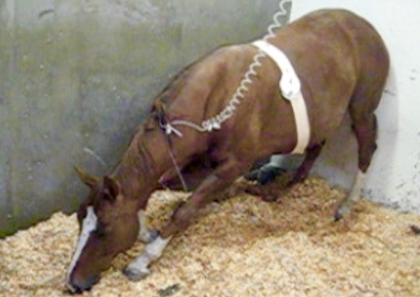 Equine Sleep and Sleep Disorders
Equine Sleep and Sleep Disorders
Sleep is essential for the overall health of the horse. Horses are polyphasic sleepers meaning that they have multiple periods of sleep (usually short) throughout the day with most of their sleep occurring at night. Our group has studied sleep in horses and defined various stages of vigilance based on continuous clinical observations with concurrent electroencephalographic studies. States of awake, drowsiness, slow wave sleep (based on EEG), and rapid eye movement sleep (REM) have been documented.
Horses can sleep about 3 hours distributed throughout the day and lasting a few minutes each time. Horses can do slow wave sleep while standing. However, if comfortable and safe, horses will lay down to do this stage of sleep. Horses cannot have and maintain REM-sleep while standing since all the muscles lose their tone in this stage of sleep. Therefore, horses must lay down to do this part of their sleep which usually comprises 20-30 minutes of their total sleep throughout a 24-hour period.
Any disruption of their sleep will result in sleep deprivation which is commonly confused with narcolepsy. Sleep deprivation is caused by lack of adequate sleep; whereas narcolepsy is a sleep disorder triggered by strong emotions and activity. It is important to rule out sleep deprivation before embarking into the investigation of a sleep disorder. Sleep disorders in horses are poorly understood. Our group is continuing to study normal and abnormal sleep including sleep disorders such as hypersomnia, disorders of REM sleep, and narcolepsy.
 Qualitative and Quantitative Characteristics of the Electroencephalogram in Normal Horses during Spontaneous Drowsiness and Sleep
Qualitative and Quantitative Characteristics of the Electroencephalogram in Normal Horses during Spontaneous Drowsiness and Sleep
Williams, D.C., Aleman, M., Holliday, T.A., Fletcher, D.J., Tharp, B., Kass, P.H., Steffey, E.P. and LeCouteur, R.A. (2008), Journal of Veterinary Internal Medicine, 22: 630–638.
Background
The influence of sleep on the equine electroencephalogram (EEG) has not been well documented.
Hypothesis
The objectives were to develop a noninvasive method of electrode placement for recording the EEG in horses and to establish normal EEG parameters for the various states of vigilance. Findings are compared with previously published reports on equine sleep based on electrocorticography (ECoG).
Animals
Five neurologically normal horses.
Methods
Overnight EEGs were recorded digitally in association with simultaneous videotaping of the horses' behavior. Data were analyzed by visual inspection, states of vigilance were identified, and representative segments were quantitatively processed. Transient EEG events were examined.
Results
Slow wave sleep (SWS) was significantly different (P < .05) in frequency and power from drowsiness and rapid eye movement (REM) sleep. Second-degree heart block was associated with SWS as were transient events commonly recognized in EEGs of humans. Drowsiness and REM sleep were similar. In both, background activity was low-amplitude β activity admixed with prominent activity of approximately 4 Hz. Standing REM sleep was associated with numerous partial collapses in 1 horse.
Conclusions and Clinical Importance
Normative data for several states were described and probable benign variants identified. This information will serve as control data for sedative and anesthetic studies in this species. The sleep patterns observed during this study are those of horses removed from their usual surroundings, and thus may represent those encountered in a clinical environment.
Additional Resources
Toth B, Aleman M, Brosnan RJ, Dickinson PJ, Conley AJ, Stanley SD, Nogradi N, Williams DC, Madigan JE. Evaluation of the squeeze induced somnolence in neonatal foals. Am J Vet Res 2012;73:1881-1889.
Williams DC, Aleman M, Holliday TA, Fletcher DJ, Tharp B, Kass PH, Steffey EP, LeCouteur RA. Quantitative and qualitative characteristics of the electroencephalogram in normal horses following sedative administration. J Vet Intern Med 2012;26:645-653.
Aleman M, Williams DC, Holliday. Sleep and sleep disorders in horses. Proc Am Assoc Equine Pract 2008;54:180-185.
